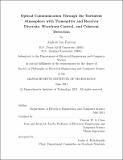| dc.contributor.advisor | Vincent W. S. Chan. | en_US |
| dc.contributor.author | Puryear, Andrew Lee | en_US |
| dc.contributor.other | Massachusetts Institute of Technology. Dept. of Electrical Engineering and Computer Science. | en_US |
| dc.date.accessioned | 2011-10-17T21:28:43Z | |
| dc.date.available | 2011-10-17T21:28:43Z | |
| dc.date.copyright | 2011 | en_US |
| dc.date.issued | 2011 | en_US |
| dc.identifier.uri | http://hdl.handle.net/1721.1/66461 | |
| dc.description | Thesis (Ph. D.)--Massachusetts Institute of Technology, Dept. of Electrical Engineering and Computer Science, 2011. | en_US |
| dc.description | Cataloged from PDF version of thesis. | en_US |
| dc.description | Includes bibliographical references (p. 253-256). | en_US |
| dc.description.abstract | Free space optical communication through the atmosphere has the potential to provide secure, low-cost, rapidly deployable, dynamic, data transmission at very high rates. However, the deleterious effects of turbulence can severely limit the utility of such a system, causing outages of up to 100 ms. For this thesis, we investigate an architecture that uses multiple transmitters and multiple coherent receivers to overcome these turbulence-induced outages. By controlling the amplitude and phase of the optical field at each transmitter, based on turbulence state information fed back from the receiver, we show that the system performance is greatly increased by exploiting the instantaneous structure of the turbulence. This architecture provides a robust high-capacity free-space optical communication link over multiple spectral bands, from visible to infrared. We aim to answer questions germane to the design and implementation of the diversity optical communication architecture in a turbulent environment. We analyze several different optical field spatial modulation techniques, each of which is based on a different assumption about the quality of turbulence state information at the transmitter. For example, we explore a diversity optical system with perfect turbulence state information at the transmitter and receiver that allocates transmit power into the spatial modes with the smallest propagation losses in order to decrease bit errors and mitigate turbulence-induced outages. Another example of a diversity optical system that we examine is a diversity optical system with only a subset of the turbulence state information: this system could allocate all power to the transmitter with the smallest attenuation. We characterize the system performance for the various spatial modulation techniques in terms of average bit error rate (BER), outage probability, and power gain due to diversity. We first characterize the performance of these techniques in the idealized case, where the instantaneous channel state is perfectly known at both the receiver and transmitter. The time evolution of the atmosphere, as wind moves turbules across the propagation path, can limit the ability to have perfect turbulence state knowledge at the transmitter and, thus can limit any improvement realized by optical field spatial modulation techniques. The improvement is especially limited if the latency is large or the feedback rate is short compared to the time it takes for turbules to move across the link. As a result, we make successive generalizations, until we describe the optimal system design and communication techniques for sparse aperture systems for the most general realistic case, one with inhomogeneous turbulence and imperfect (delayed, noisy, and distorted) knowledge of the atmospheric state. | en_US |
| dc.description.statementofresponsibility | by Andrew Lee Puryear. | en_US |
| dc.format.extent | 256 p. | en_US |
| dc.language.iso | eng | en_US |
| dc.publisher | Massachusetts Institute of Technology | en_US |
| dc.rights | M.I.T. theses are protected by
copyright. They may be viewed from this source for any purpose, but
reproduction or distribution in any format is prohibited without written
permission. See provided URL for inquiries about permission. | en_US |
| dc.rights.uri | http://dspace.mit.edu/handle/1721.1/7582 | en_US |
| dc.subject | Electrical Engineering and Computer Science. | en_US |
| dc.title | Optical communication through the turbulent atmosphere with transmitter and receiver diversity, wavefront control, and coherent detection | en_US |
| dc.type | Thesis | en_US |
| dc.description.degree | Ph.D. | en_US |
| dc.contributor.department | Massachusetts Institute of Technology. Department of Electrical Engineering and Computer Science | |
| dc.identifier.oclc | 756043312 | en_US |
